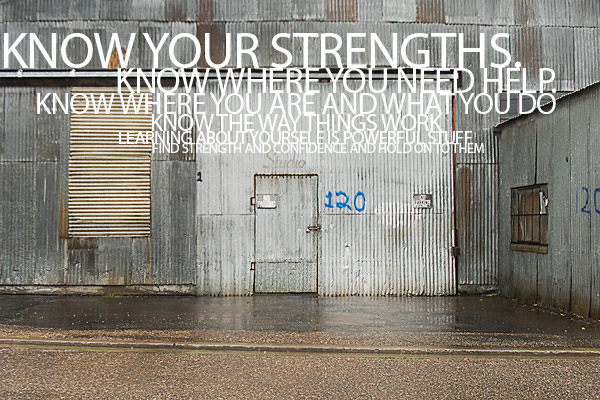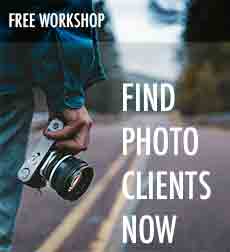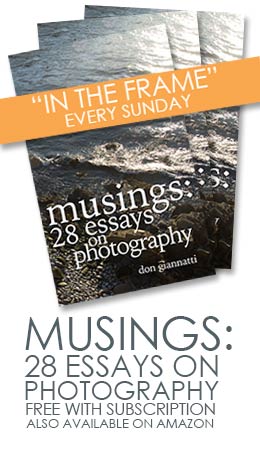It is one of the paradoxes of our business that one cannot get assignments until one has done assignments. “How do I get assignments if I don’t have any work to show the clients” is an often-heard complaint.
And it is a complaint not without merit. It is tough to get up that first rung of the ladder. Getting from amateur or even semi-pro to the place where more exciting assignments are rolling in takes time and perseverance and careful calculation. And, maybe, just a little bit of luck. Being prepared for that “lucky moment” is one of the things we are doing as we build our book and gain experience.
A Strategic Plan. Part One: Discovery
First lets look at the reasons why clients want to know, really know, that you can do the work that they have to give you. By the time an assignment has gotten to you, it may have been hashed through several long meetings with the client. The idea may have changed a couple of times since its first inception, and that may add challenges to the final piece. Financial concerns and portfolio reviews and revised layouts have been looked at, argued over and finally agreed upon.
(I should state that this is a long article, so if you have no time at the moment, bookmark it for later perusal.)
Many times we have no idea of what took place behind the scenes, we only have an art director or client representative in the studio with us. The over-riding concern is that you won’t screw it up. The over-riding hope is that you will not screw it up AND bring something interesting to the shoot. Note that not screwing it up is quite important.
An AD or Editor or Designer may have had to fight a little for this concept, and maybe they went to bat for a bit more in the budget to get the photography right.
Don’t screw it up.
When clients see the work that you have done for other clients they are seeing your ability to deliver what was promised. They see you as being someone trustworthy and experienced – with someone else’s budget, demands, temperament, goals, project – and you delivered.
And you didn’t screw it up.
Call it the ‘warm, fuzzy factor”. Call it credibility. Call it a lessening of the terror-gripping-stomach-cramping-uncertainty factor.
It is important to them.
And it is important to you.
As bad as they don’t want you to screw it up, YOU don’t want to screw it up even more. Understanding this common goal can lead to a better relationship with prospective clients. Sure they want to see some amazing shots, but they also want to keep their jobs and their clients and their sanity.
I can remember sweating bullets over what now would be considered hum-drum product or still life work. I would be completely in knots if the shoot involved others… models, MUA, stylists. I needed to be the big Kahuna on the shoot, and I needed to have folks who wanted me to be the big Kahuna. Or at least be comfortable with me being TBK.
That means I had to have credibility with them as well. The support that we get from our staff – even the temp ones – is so important for our sanity on set that we do as much as possible to keep them looking to us for direction. Nature abhors a vacuum… if you aren’t TBK, someone else will be. (Scary)
I eventually came to relax a bit, but there is still a sense of urgency and a disquieting sense of ‘did I get it all prepared’ running through my mind before shoot time. I want the client to love the shot. I want everyone to love working with me.
I don’t want to screw it up.
Ever.
Lets get granular after the jump:
How does one go from shooting for personal fun to shooting for clients?
We will examine that in a couple of posts coming up here on LE, but let’s look at preparation first.
Selina calls it “Showing Up” and it really is just that easy. Or that hard.
Being prepared both mentally and physically. Being prepared to be inspired and inspiring. Being prepared to demand the absolute best from yourself and your staff… and – your client. Yes, you can inspire your client to work hard WITH you if you are working and generating a real expectation of excellence.
Show up, and show up prepared.
Let’s view the reality of getting a book together for a commercial shooter in a small or mid-size market. Getting out and into the working commercial market has different trails these days. The assistant / studio manager / shooter route has been diminished for a lot of areas (I know in Phoenix it is nearly non-existent), so we must find other paths. And that has deprived starting out photographers from that experiential thing that is so damn important.
It is certainly fun to watch big time photographers on YouTube shooting big time assignments with big time models for big time agencies. Yes it is.
What we didn’t see was all the small time work with small time agencies that was usually the ticket to the big time agencies. And models.
And we didn’t see the other 90% that is being a commercial photographer. Calling clients, managing the schedule, billing, working with advances – hell, GETTING advances, and the myriad challenges both time-wise and creatively that must be faced and dealt with.
It is not the same as shooting on the weekend and getting images to someone when time permits. It isn’t the same as shooting on vacation and getting around to the post when the following weekend comes. That may be fine and the images may be incredible… but that isn’t the BUSINESS of what we are doing here.
And note: I am not addressing wedding and portrait photographers, art photographers or any incredible hobbyists out there. That can be EXACTLY how it works in those worlds, and there is nothing wrong with it at all.
But when we make that change, and want to go pro – commercial pro, we have to change our mindset drastically. Sure it’s about the image. And sure, it isn’t all about the image.
What it is totally about, though, is you. How you do what you do. How important you think what you do is. How engaged you are with even the simplest of projects.
Working toward getting a book together takes perseverance, practice, a critical eye, and courage.
Yes. Courage.
Courage enough to know that the shot is good. Courage to have the confidence in your work. Courage to face the fact that it may not be good at all. Courage enough to get back at it and NOT quit until it is as good as you can make it.
Courage enough to reshoot it. And again to get it right. And possibly… again.
Rinse and repeat.
How will you be able to be confident that you can shoot a pour shot for a local restaurant? Well, for one thing, you have shot a bunch of them for your portfolio. Dark beer, light beer, wine, water, soda, brown likker… into glasses, mugs, shot glasses, over grapes, into the mouth of a model, over ice cubes in a tall cylinder, off the side of a truck, over the head of a coach, against a white background and a black background and a stainless steel background and… I could go on. You get the message though… You have done it.
And, no, you don’t have to have shot every one of my examples, but I hope that you have shot a few of them. And gone online to see what others have done. And after researching what others have done, KNOW what is good and what is not.
Amass a pile of cool pour shots, and take them apart. Do you feel you can do those shots? You better. Cause that is what you are gonna have to do, right? At least something similar will be requested. Probably. Maybe.
But before we start pouring every liquid in reach over our buddies football helmet, let’s find out a little more about our area. Where we work and live and plan on having a career is a given for most of us. We are not planning on moving to a loft in SoHo and beginning a fashion studio. Most of us anyway.
So we start by identifying our market.
- Where do you live/work?
- Is there a market for commercial work there?
Prove it. Who? What do they do? Are they regional or local?
Do they use anyone locally to shoot for them? - Have you gone through the phone book to see who is listed under “Photographers, Commercial”? Paper and online and Google and Facebook?
How many are there? Where are they located - What do the portfolios of those you found in #3 above look like? Are they wedding/portrait shooters who have adopted the term ‘commercial’ for marketing or the occasional product shot that comes in? Do they have staffs? Are they doing work for local / regional clients? Are there tear sheets or client lists that confirm?
- Does the work of these photographers require any special equipment or access? Trying to go up against an aerial shooter with her own plane may require a bit of capital… or a hell of an idea.
- Does the work hold up against the stuff you love? Is it modern looking? Is it well done from a technical standpoint?
- Is it stylistically sound? That is to say, does the photographer have an identifiable style? Is it ‘hip’ or ‘classical’? Is it post-processed based? Can you reasonably approach that style if asked to? Would you?
- What are the photographers you have found in your vicinity showing in their books? Fashion or ‘Seniors”? Still life or landscape? Product or corporate? How many in your area are shooting in the disciplines you want to shoot in? Make a list. Count it up… you are tallying the competitive edge that others have, and you are preparing a metric that you will use to determine what to do next.
- Gut check. What do YOU want to shoot? What do you love to shoot? Will you be one of the herd or a leader of the area? Can you deliver something that they cannot? NOTE: we are not talking about cheaper, got it? Telling me that you can work from you garage and deliver the same ol same ol for a few schillings less makes me grumpy. IMAGES and PHOTOGRAPHERS have worth that is intrinsic in what we do. We ain’t cannin’ peas here.)
- Make a folder with this information. Look at it and make some notes about what you have found. Organize it into categories: Who, What, Where, How and Style. NOTE: this is not a way to cheat, it is important information for you.
Make these lists. Do it now.
(EDIT: In response to an emailer. I would think you should do this with at least ten shooters in a small to medium market (Columbus, Albuquerque, Tucson, Fort Lauderdale). If you are in a larger market go for 18-20 (Atlanta, Miami, Houston, Seattle). If you are in a big town… 25 should be sufficient (LA, NY, CHI). It is not easy to do, but I did not promise nor would I endorse easy. I would bet that for every 50 people who read this, less than 5 will actually do it. Showing up… easy – and hard.)
We will discuss what to do with them on a post next Friday (April 15, 2011).
(NOTE: Wedding / portrait shooters… you should do this too.)
You can certainly NOT do this if you want. It is, after all, up to you to make the decisions that will lead you toward understanding where you fit in.
We are not going to disparage the photographers in your area. This is not ‘unfair’ or ‘unethical’… it is business. In my design/ad agency we do SWOT analysis all the time. We want to know what others are doing NOT to copy them, but to make sure we can message our clients without copying them. Finding a message point is not a bad thing. Knowing what is working or not working or simply ‘there’ can help you formulate strategy, implementation and success.
Finding out where you sit in your area is NOT a bad thing either. It is a business process. And it is important.
I look forward to discussing this here on the LE site, and ESPECIALLY for those of you who are working on Project 52.
As always, discussion in the comments is encouraged. Share with us what you have found out about your area.
As always, I am available for stalking at Twitter, the Facebook Page is here, and if you are interested in a workshop, Learn to Light is a great place to start. See you next time.






Great post, Don. This type of info is gold
Thanks for this great post, Don. This is a great help in organizing my thoughts and finding a starting point. Getting to work right now!
Good post (as always) – and accurate.
Another conundrum you can’t underestimate: as long as you stay in your 9-5 job you really won’t get taken serious, and you really need that full calendar flexibility of being able to shoot anytime during the week in order to be taken serious. However, it will take a while before the assignments coming in will replace the 9-5 job financially. So be prepared to bankroll the transition accordingly. You really can’t wait until you have enough assignments before quitting, or it will just never happen. But don’t expect it to fall into place. Ideally you should be able to cover your living expenses for 12-18 months through savings or other means with an extremely flexible schedule.
It’s a good gut check to have done at least one assignment in each category you hope to work in before you jump. But once you’ve got those checked, get your finances straightened out and get on with it.
Great post Don. I remember you saying at a workshop that you need to shoot what you want to be known for and what you want to shoot. Many of us start out shooting portraits, sports or weddings or a combination of these to get a start and pay the bills. And then we want to make the jump into commercial work and still pay the bills while doing it. So we still need to do the portraits or the weddings, and even the sports teams at times. Your checklist is applicable to any field of photography. In fact calling clients, managing schedules, billing and even getting advances is also a problem for “non-commercial” photogs at times for large-scale portrait projects. This must be the week for these types of posts – see Kirk Tuck and Chase Jarvis blogs
Great post as always Don.
Really hits the nail on the head, I think identifying the available market is perhaps the most important step in becoming a commercial photographer. I think I’ve identified one for me, but without going out there to see I’ll never know.